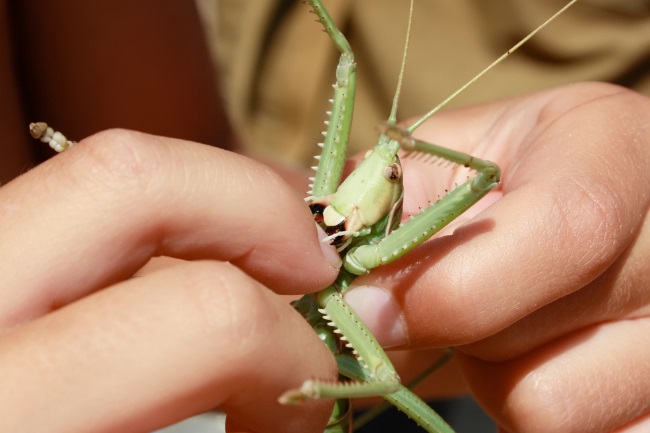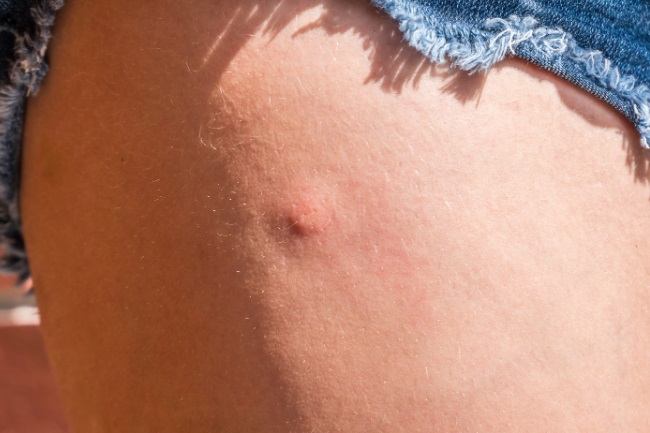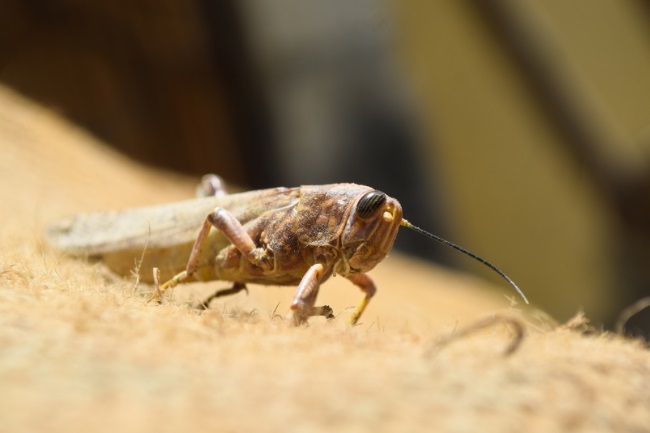Grasshoppers really are the pacifist of the insects. They don’t have stingers and rarely choose to bite as a defence mechanism. Instead, their survival strategy is to hop or fly away, choosing flight rather than fight.
Contents
Do grasshoppers bite humans?
Grasshoppers are herbivorous insects, meaning they eat plant matter. They do have the mouthparts to bite, as they need them to rip off and chew their leafy meals. These are composed of mandibles that can grip and cut their meals, and then the maxillae behind, that help chew up and provide further cutting. Above and below are the labrum, the upper jaw, and the labium, the lower jaw. However, unlike some insects, like mosquitos or ticks, these aren’t adapted to eating meat or sucking blood. This means the only reason they would bite a human would be in self-defence.
| Behavior/Defense Mechanism | Explanation |
|---|---|
| Biting Ability | Grasshoppers have mandibles that they use for feeding on plants. They may bite if they feel threatened or cornered. |
| Stinging Ability | Grasshoppers do not possess stingers and are incapable of stinging. |
| Spitting or Regurgitating | Some grasshopper species have the ability to spit a defensive fluid or regurgitate unpleasant substances when threatened. |
| Warning Colors | Certain grasshopper species exhibit warning colors or patterns to deter predators, signaling their unpalatability. |
So why would a grasshopper bite a human? In general, these insects have much more to lose than gain from a quick nip, unable to seriously injure their opponent but at significant risk of being squashed or eaten for the impertinence. Therefore they would only bother to try and bite us if they were desperate to escape. The most likely reason for this would be a human picking them up and holding on to them in a tight grip.

Their primary option for biting would involve using their mandibles to pinch our skin, however, as most grasshoppers are pretty small, often 1-2 inches long, these appendages would usually be too weak to even be felt and definitely too small to break through the skin.
There are some larger grasshopper species, such as the Eastern lubber, the female of which is 3 inches long. For some of these, it is possible that we would feel a slight pinch. However, most grasshoppers won’t even bother to try and bite.
Grasshoppers’ main defence mechanism is escaping. Their impressive hop is designed to get them out of danger as quickly as possible. Alongside this, they use camouflage, warning colours and sound to keep predators at bay. If all else fails, they may sacrifice their own limbs to get away from danger, disconnecting their legs and limping away without them.

Some grasshopper species, known as locusts, can become more aggressive and likely to bite if they enter their gregarious, swarming stage. This occurs during certain environmental conditions and results in large numbers of locusts gathering together, when they are generally solitary, and becoming eating machines, often decimating crops. During this phase, they may be more likely to bite if handled.
Also read: How do Grasshoppers Protect Themselves? (Explained)
Does a grasshopper bite hurt?
If the majority of grasshoppers were to try and bite you, you most likely wouldn’t even feel it. With larger species, you may feel a slight pinch. Of course, it’s never nice to be bitten, and it’s not particularly pleasant for the grasshopper to feel that it has to bite you to survive, so it’s best not to handle grasshoppers roughly or in a way that might damage them.
What does a grasshopper bite look like?

If you are bitten by a grasshopper, you’re likely to get a raised red lump like other insect bites. This should be washed with soapy water. If a reaction occurs, you should visit your doctor, though you are unlikely to have a severe reaction as grasshoppers do not have venom.
| Behavior/Effect | Explanation |
|---|---|
| Biting on Humans | While grasshoppers may bite if provoked, their bites are generally harmless to humans and cause minimal pain. |
| Allergic Reactions | Some individuals may be allergic to grasshoppers, and their bites may cause mild allergic reactions, such as redness, swelling, or itching at the bite site. |
| Disease Transmission | Grasshoppers are not known to transmit diseases to humans. |
| Handling Precautions | It is generally safe to handle grasshoppers with bare hands, but if concerned, using gloves or gentle handling techniques can minimize the risk of accidental bites or skin irritation. |
Do grasshoppers have stingers?
Stingers are sharp; hardened appendage used to inject venom into another living creature. While we refer to venom-injecting appendages in the mouth as fangs, those elsewhere on the body are generally called stingers or spines.
Bees and wasps are both famous for their stingers, but many other animals have them, such as stingrays and scorpions. Though the pointed nature of the stinger allows it to push into the skin, which itself causes a level of pain, it is the venom that increases this discomfort or even makes it deadly. Most bee species can sting multiple times without injuring themselves, though famously, the honey bee gets its stinger stuck in mammal skin, causing it to die.

Luckily for us, grasshoppers do not possess a stinger or venom, though some are themselves poisonous if eaten. What many people confuse for stingers is the long pointed appendage on the end of the abdomen of some grasshoppers. This is an ovipositor, the part of the female grasshoppers used for receiving the male’s sperm and for egg-laying. In some senses, they do use the ovipositor a little like a stinger, using it to press down into the soil or a plant stem to lay their eggs.
There’s a good reason why the two would be confused though, as the stings of bees and wasps are actually ovipositors that have evolved over time to become stings. It’s for this reason that only female wasps and bees have them. Truly the female of the species is much deadlier than the male.
Also read: How do Grasshoppers Reproduce? (Eggs & Mating Explained)
A scrape is as good as a sting
When handling grasshoppers, something that many people mistake for a sting is the sensation of the grasshopper’s skin scraping across theirs. As grasshoppers are athropods, they have a hard exoskeleton rather than an internal spine. This means that when we handle them, ridges and sharp points on their bodies may scratch us as they try to get away.
In particular, they have raised ridges on the backs of their hind legs. These are designed for them to be scrapped across their wings to create that characteristic grasshopper song. One grasshopper defence mechanism can be to kick out their feet to ward off danger. This is harmless enough to us humans, but if your skin happens to interact with the grasshopper’s legs, the hardened raised ridges may scratch.
As with all scratches, there’s likely to be some discomfort, raised lumps and redness. However, a little soapy water and some antihistamines are a good cure-all in cases like this. Perhaps in the future, it might be worth wearing gloves if you need to handle large grasshopper species.
The pacifist of the insect world
Insects get a bad name for irritating or hurting human beings. Wasps are hated for their stings, ants for their bites and spiders feared no matter what size they are. Yet the majority of insects are simply getting on with their day, barely aware that we exist, and certainly not planning to get on our bad side.
Grasshoppers live relatively short lives, emerging as nymphs in the spring, feeding and growing throughout the summer, and then singing their songs into the evening air as they try to romance the opposite sex. As winter comes, the adults have passed away, and the young are tucked up safe in their egg sacks.
Throughout all this, there are a hundred hungry predators keen to get a mouthful of grasshopper, from birds to mammals, even to other insects. Without venom, a stinger, or even fangs, the grasshopper doesn’t have much to defend itself with, so its best bet is to hide as best as it can and escape when it’s found. So the fact is that, like many insects, grasshoppers really are much more scared of us than we are of them, and their fear is much more justified.

